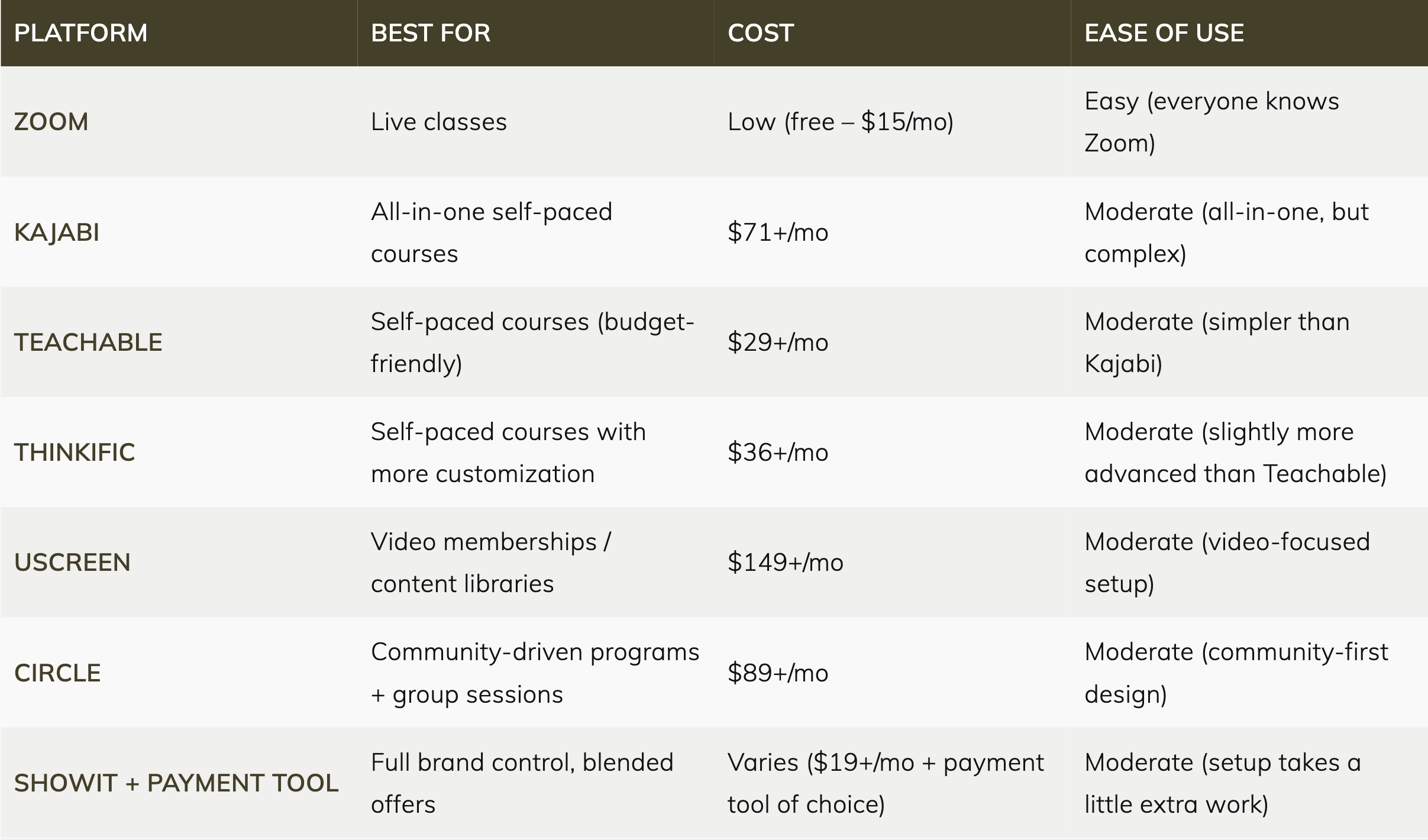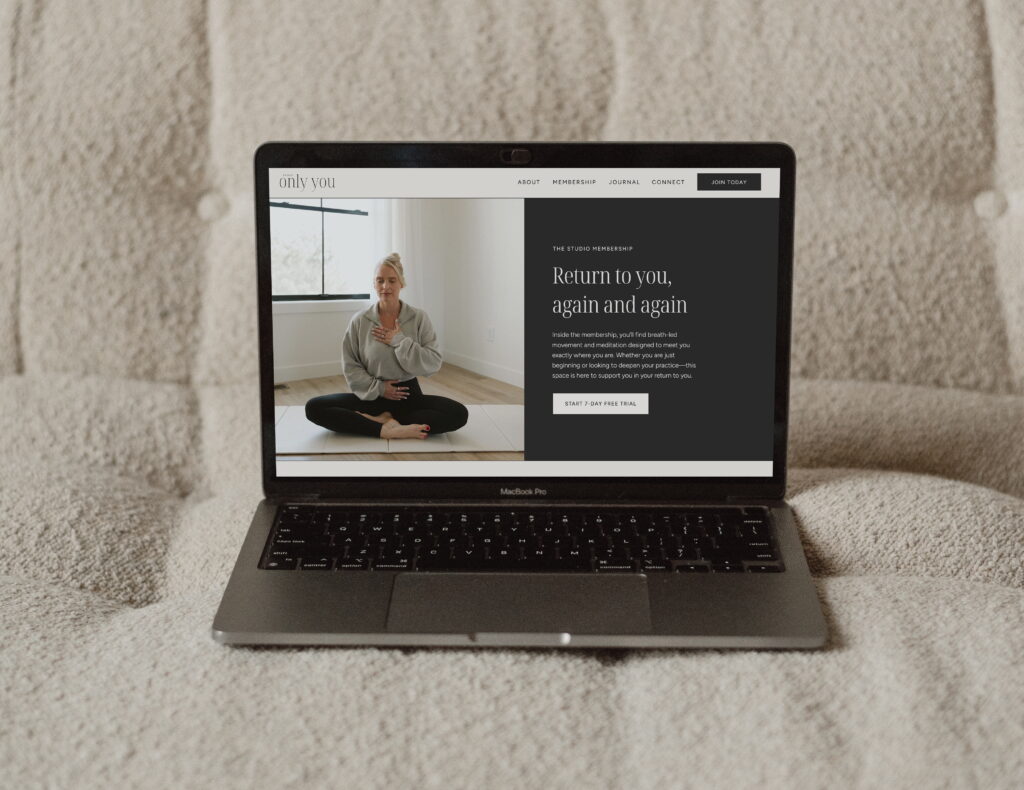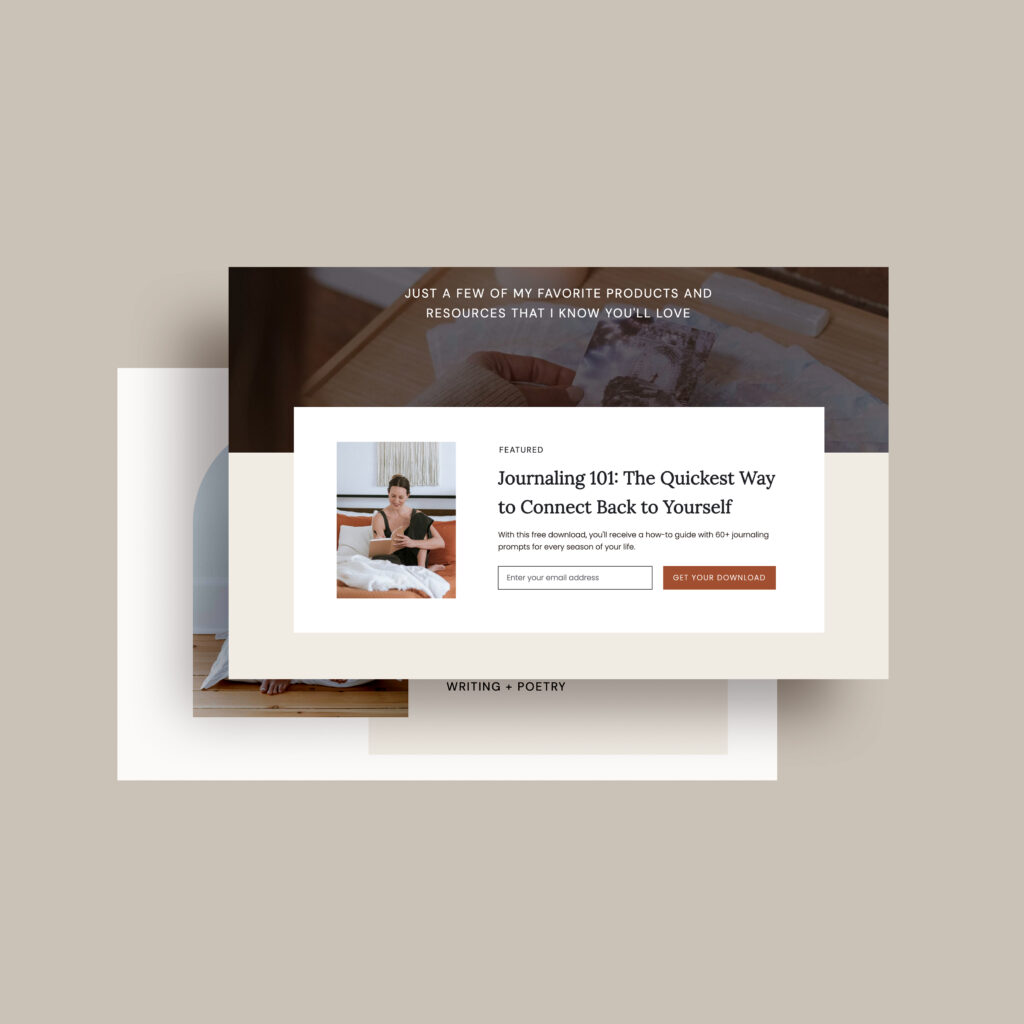
October 2, 2025
Picture this: you’ve got an idea for a course. Maybe it’s a series for mastering yoga poses, a nutrition reset, or a group coaching package you know could change lives. But then the spiral starts: Do I need a fancy platform? How do I even get people to sign up? What if I build the whole thing and no one buys it?
That spiral? Totally normal. It’s where most health and wellness professionals get stuck. The creation part feels exciting, but the selling part feels.. weelll, like staring at a necklace chain that somehow tied itself into a million little knots.
Selling a course doesn’t actually have to be complicated. It shouldn’t be about chasing the latest software or having to learn all the sales funnels. It should be about picking the right setup, telling people clearly what they’ll get in a way that resonates with them, and making it ridiculously easy for them to hit that signup button.
1. Choose the best platform to sell your online course
Let’s start with the platform. Once you’ve got an idea for your course, one of the next big questions is usually: Where should I host it? Do you need Kajabi or Teachable? Can you just run your yoga classes on Zoom? Or is there a way to connect your existing site so you don’t start from scratch? (And if you don’t have a website yet… we should probably talk. Please read this.)
There isn’t one perfect answer. It depends on what you’re teaching and how you want to deliver it.
- Live classes (ex: yoga, meditation, nutrition workshops): Zoom is the simplest starting point. Pair it with a basic booking tool and you’re ready to go. It’s familiar for clients and budget-friendly if you’re testing an idea.
- Self-paced courses (ex: recorded series): Platforms like Kajabi, Teachable, or Thinkific keep everything in one place like videos, modules, and payments. They come with a higher monthly fee, but they make the student experience smooth. (Smooth experience = happy students = repeat clients.)
- Membership or video library: If you want to sell ongoing access to a library of yoga flows, meditation sessions, or regular workshops, Uscreen is a strong option. It’s built for video-first businesses and makes it easy to livestream, add replays, and even build branded apps overtime.
- Community-driven programs: If group interaction is part of your offer (like group coaching, peer support, or a wellness membership), Circle is a great fit. You can host course content and create a space where members connect, share wins, and stay accountable.
- Blended offers (ex: course + coaching, recordings + live): Think a self-paced nutrition program with weekly group calls, or a yoga library plus live Zoom sessions. When you have a few different pieces like this, you might want to think about integrating them into your website. All you need to do is integrate a checkout tool like ThriveCart or Stripe and deliver the content through a private members-only page. This route is great because it gives you the most control over your brand and student experience. And if you don’t have a site yet, Showit is one of my favorite platforms for wellness brands because it’s flexible, easy to update, and can be designed beautifully without any code.
So to sum up, if you’re just starting out with live sessions, try starting with Zoom. If you’re ready to scale with a course library or community, look at Uscreen or Circle. If you want everything bundled, Kajabi, Teachable and Thinkific can do it all. And if you already have a site you love, adding checkout + members-only access might be the smoothest path.

2. Price and position your course
Once you know where your course will live, the next step is deciding what to charge. This part can feel tricky for sure, because you want your course to be accessible, but you also need to price it in a way that reflects the value and keeps your business sustainable.
A few things to consider:
- Market check → look at similar offers in your niche. What do online yoga memberships, nutrition resets, or group coaching programs cost? You’ll notice a wide range, so use this as a reference point and not a rule.
- Transformation over time → Your price shouldn’t just be about hours of content. A 6-week program that helps someone finally feel energized every morning is worth far more than six 60-minute videos. Focus on the outcome, not the length.
- Format matters → A self-paced video course usually costs less than a hybrid offer with live coaching or community support. A $49 mini-workshop, a $297 nutrition reset, or a $1200 coaching package all make sense – it just depends on the level of access and support you’re offering.
- Confidence counts → Pick a number you can say out loud without cringing. You can always adjust later as your course grows, but you need to feel good about the price to sell it effectively.
3. Create a selling page that converts
Once you’ve decided on your pricing, it’s time to put your program somewhere people can actually say yes and sign up. That place is called a sales page.
A sales page is just a single page on your website (or on your course platform) that’s dedicated to one thing: explaining your offer and making it easy for someone to buy. Think of it as the online version of having a conversation with a potential client. Instead of you walking them through what your course is, who it’s for, and how it helps, this sales page does that job for you.
Here’s what to include on a strong sales page:
- A clear headline → say what the course is and who it’s for. Example: “A 4-week yoga reset for busy women who want more energy and less stress.”
- The transformation → highlight the results, not just the features. Instead of “6 modules and 12 videos”, say something like “Learn how to meal plan in 15 minutes a week.”
- What’s inside → give a simple breakdown of what they get (modules, lessons, live calls, community access, etc.).
- Trust builders → testimonials, success stories, or even a short note about your experience. This helps people feel confident signing up.
- A simple way to join → one clear button or link repeated a few times down the page, so there’s no confusion about what to do next.
Every section on your sales page should answer one question: Will this make it easier for my future student to say yes?

4. Build an email list (your secret sales tool)
Now your sales page is ready to go and the question becomes, who’s actually going to see it? That’s where email comes in.
To me, social media is like shouting into a busy room – some people might hear you, but most won’t. Email is different. When you land in someone’s inbox, you’ve got their full attention. And even if your list is tiny, those people are already interested in what you offer, which makes them waay more likely to sign up.
So how do you start? Offer something small and valuable that ties into your course. If you’re creating a nutrition program, maybe it’s a free 3-day meal plan. If you’re a yoga teacher, it could be a short video series on morning stretches. That freebie becomes the entry point: people download it, they join your list, and now you’ve got a way to keep in touch.
And then from there, you start sending a few emails that feel like a conversation – not a campaign. Share a story, give them a tip they can use right away, and then invite them into your course as the next step. It doesn’t need to be fancy. Just consistent and human.
5. Marketing ideas that actually work for wellness courses
With your email list set up, it’s time to bring in more people who might want what you’re offering. This is the part that can feel overwhelming because there are so many options and it feels like you need to be everywhere at once. But you don’t.
The best marketing plan is the one you’ll actually follow.
If you already like writing, start with a blog and repurpose it into Instagram posts, Pinterest posts, or short emails. Blogs are especially powerful because they keep working for you long after you hit publish – showing up in search, driving traffic, and building trust. I wrote more about why blogging is important in this post.
If you prefer being on video, record a few tips for IG, TikTok, or YouTube and then embed them on your site. Every piece of content should point back to your freebie and your sales page. That’s how you keep things connected.
Here are a few ideas that tend to work well in health and wellness:
- Evergreen content → things like “5 yoga poses for better sleep” or “3 ways to beat afternoon sugar cravings.” These keep working long after you post them.
- Seasonal promos → short-term offers like a “back-to-school reset” or a “holiday stress workshop.” These are great for creating urgency.
- Collaborations → partner with another teacher, practitioner, or coach. Guest teach in their group, do a live together, or trade email mentions.
- Pinterest → still a great platform for wellness content, because people go there searching for solutions (and pins last for months!)
The goal isn’t to try every strategy at once. It’s to pick 1 or 2, do them consistently, and always guide people back to your email list and sales page. That way, your marketing is working even on the days you’re not.

6. How to sell without feeling salesy
After you’ve done the work of building your email list and getting the word out, the next step is inviting people into your course. And this is usually the part that feels more tender. I know because I’ve been there too – talking about your own offer can feel awkward, even when you deeply believe in it.
But here’s the shift: selling your course isn’t about convincing people, it’s about inviting the right people into something that could help them. Think of it like recommending your favorite yoga mat or a recipe that actually tastes good – you’re sharing because it could make their life better.
Here are a few ways you can keep it authentic:
- Use plain language. Might sound obvious, but if you start explaining your course like you’re teaching a college lecture, you’ll lose people fast. For example, instead of “learn how to increase proprioception and mobility”, you’d want to say something like “learn how to feel more balanced and flexible in everyday movements.” Or instead of “develop self-regulation strategies to reduce stress”, say “find simple ways to stay calm when life gets overwhelming.” See how that instantly become so much more relatable?
- Focus on the transformation. Instead of “12 video modules”, say “learn to meal plan in 15 minutes a week.”
- Share stories. Real client experiences or even your own journey will always feel more genuine than bullet-point benefits alone.
- Keep the invite simple. “I’d love to have you join me” goes further than “enroll now before it’s too late!”
When you approach sales as a service, the whole energy shifts and you’re not chasing sign-ups. You’re opening a door for the people who’ve been looking for exactly what you created.
Quick checklist: The best way to sell your course
We’ve covered a lot, but here’s your bird’s-eye view. If selling your course feels like a spiral, keep this list close and just move through it step by step:
- Pick your platform → Some good options to look into are Zoom for live, Kajabi/Teachable/Thinkific for self-paced, Uscreen for memberships, Circle for community, or your website for a branded setup
- Set your price → Choose a number that reflects the value of the transformation and feels good to say out loud
- Create your sales page → Clear headline, outcome-focused copy, what’s inside, social proof, main CTA
- Build your email list → Offer a simple freebie that ties into your course and start a short nurture flow
- Market your offer → Repurpose content, collaborate, use Pinterest or seasonal promos
- Sell authentically → Talk like a human, share stories, invite rather than push
That’s it – six steps. No overcomplication, no chasing every new tool. Just a simple plan to get your corse into the hands (or computers) of the people who need it.
Ready to launch your course?
Selling a course doesn’t have to feel like untangling a knotted necklace. With the right setup, clear messaging, and a way to reach your people, it becomes less about “selling” and more about sharing something valuable you created.
If you’re ready to launch but stuck on the tech or design side, that’s where I love to help! At VERVE & COLOR, I create Showit websites and sales pages that are built to look beautiful and convert. Let’s untangle the tricky parts together so you can get your course out into the world and start making the impact you’re here for. Click here to get started ✨
—
Note: Some links on this page are affiliate links, so I may earn a small commission if you purchase through them (at no extra cost to you). Sometimes, you’ll get a discount or special bonus for using them.

Vickie is the founder of VERVE & COLOR, a creative studio crafting elevated, intentional websites for health and wellness brands. She’s spent over a decade studying and practicing wellness—from holistic nutrition and meditation to sound therapy and somatic healing—alongside a career designing digital experiences for global companies. Today, she blends both worlds to create websites that are not only beautiful and easy to use, but rooted in the heart of the work her clients do.